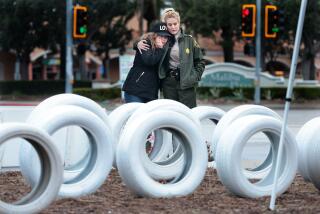Barriers at Wreck Sites Are No Help
- Share via
Dear Traffic Talk:
I understand that in some countries, opaque barriers are placed around the scenes of working traffic accidents to discourage rubbernecking by drive-by ghouls and the “just curious,” hence, ideally preventing backups and traffic jams.
Why don’t we do that here? There has to be a good reason, right?
Ann Muenter, Van Nuys
*
Dear Ann:
People will stare, regardless of what’s happening on the road, said Officer Lou Aviles, a spokesman for the California Highway Patrol.
“Human nature makes us inquisitive creatures, and we want to see what’s going on,” Aviles said. “The fact that we are deliberately obscuring a driver’s view would make them want to look even more, and possibly create a greater traffic hazard.”
Aside from human nature, there are other reasons why the CHP doesn’t place barriers around traffic accidents.
If the barriers fell, they could land on other vehicles driving along the freeway. Also, the CHP would have to develop a vehicle and hire a driver to transport the barriers to an accident, Aviles said.
Accident scenes need as much space as possible to allow ambulances, tow trucks and sometimes helicopters to get to the scene. In most cases, the CHP is able to clear the road and move wrecked vehicles off to the side in minutes.
****
Dear Traffic Talk:
A recent study showed that Riverside County had the most dangerous drivers in the country. One of the items listed as being considered dangerous was passing on the right. In what form of passing on the right are they referring to?
It seems the majority of drivers insist on driving in the left lanes, making passing on the right the only alternative.
The California Vehicle Code clearly states to drive in the right lane and pass only on the left, but on any given freeway drive, you see more drivers in the left lanes than in the right, some going below the posted speed limit. Why aren’t the problems with slow drivers more aggressively enforced?
Kip Holsher, Rosamond
*
Dear Kip:
The survey you’re referring to says that aggressive drivers pass traffic by driving on the right shoulder, a lane reserved only for emergency vehicles, said Officer Aviles.
It is not illegal to pass on the right, unless you’re driving off the road to do so, said Bill Gengler, a spokesman for the Department of Motor Vehicles.
“If an officer comes upon a slow driver that’s considered a hazard or impeding traffic in the fast lane, it’s something we get involved with,” Aviles said. “But just because the speed limit says 65 doesn’t mean people have to go that fast.”
He said CHP officers don’t usually find slow drivers in the fast lane, but they often find drivers going too fast.
****
Dear Traffic Talk:
What does one do when confronted with breaking the law when it’s unsafe to follow it? The Winnetka Avenue onramp to the southbound 101 Freeway consists of two lanes, one for single drivers, another for carpoolers with two or more people inside.
When driving south on Winnetka and turning left onto the onramp, the driver has two choices: turn left into the left-hand lane, which is the carpool lane, or land in the right-hand lane if there are no passengers in your car.
The problem is, if a steady stream of cars driving north from Winnetka Avenue turn right onto the onramp, the right lane of the ramp gets full and it is unsafe to turn into that lane. The only safe choice is to turn into the diamond lane.
If the law is followed, the situation is an accident waiting to happen. If the freeway is entered from the diamond lane without a passenger, the situation is a ticket waiting to happen. What do you suggest as a course of action?
Denis Robinson, Van Nuys
*
Dear Denis:
Your only option is to wait a little longer before turning into the correct lane on the freeway onramp, Aviles said.
“Knowing the congestion at that left turn, all you need is a little patience before turning onto the freeway,” Aviles said.
*
Traffic Talk appears Fridays in The Times Valley Edition. Readers may submit comments and questions about traffic in the Valley to Traffic Talk, Los Angeles Times, 20000 Prairie St., Chatsworth 91311. Include your name, address and phone number. Letters may be edited, and no anonymous letters will be accepted. Fax letters to (818) 772-3385. E-mail questions to valley.news@latimes.com.
More to Read
Sign up for Essential California
The most important California stories and recommendations in your inbox every morning.
You may occasionally receive promotional content from the Los Angeles Times.












